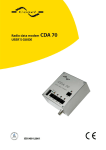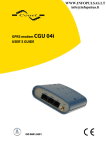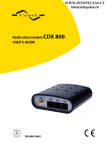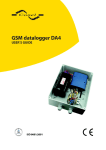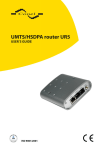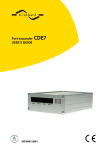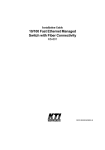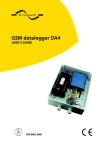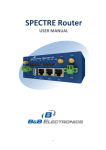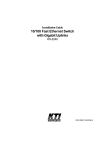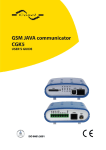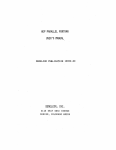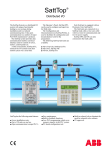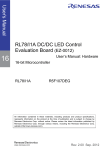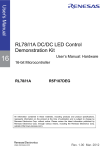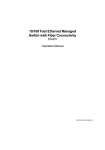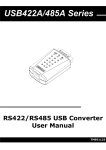Download Declared system ISO 9001:2009
Transcript
Declared system ISO 9001:2009 CONTENTS Contents 1. 2. Safety instructions Description of the CDA70 radio modem 2.1. General 2.2. Examples of possible applications 2.3. Description of individual components 2.3.1. Radio component 2.3.2. Modem component 2.3.3. Microcomputer 2.3.4. Inputs and outputs for telemetry 2.3.5. User interface protocols 2.3.6. Technical parameters 2.4. Radio modem status indication 2.5. User interfaces (connectors) 2.5.1. Connection of PORT1, PORT2 and PORT3 connectors (RS232) 2.5.2. Connection of PORT1 connectors (M-BUS) 2.5.3. Connection of PORT2 connectors (RS485G) 2.5.4. Connection of ETH connectors (ETHERNET) 2.5.5. Connection of I/O connector 2.5.6. Power supply connector (PWDD) 2.6. Antenna connection 2.7. Power supply 2.8. Ports technical specifications 2.9. Configuration of radio modem 2.10. Service cable 2.11. Accessories 2.12. Additional accessories 2.13. Mechanical drawing of CDA70 and recommendations for montage 2.14. Product marking 2.15. Assembly procedure 2.16. Product label 2.17. Basic parameters description 3. CIO - analogue inputs and binary outputs 3.1. Introduction 3.2. Description of multi-purpose signal evaluation and reception 3.2.1. Analogue input 3.2.2. Binary output 3.2.3. I/O signals inside CDA70 3.2.4. I/O signals parameters 3.3. Measuring other CDA70 signals 3.3.1. Measuring the supply voltage 3.3.2. Measuring internal CDA70 temperature 3.3.3. Measuring DSR output signal level 3.4. Output signal for disconnection of supply voltage 3.5. Technical parameters 3.6. Connecting CIO signals to user device 4. Reference 5. Links to related products of the manufacturer 2 4 5 5 5 5 5 6 6 6 7 8 9 9 10 11 12 14 14 16 18 18 19 22 22 23 23 24 27 28 30 31 35 35 35 35 35 35 36 36 36 36 37 37 37 37 39 39 CONTENTS 5.1. Systems 5.2. Protocols 5.3. Software 5.4. Products 6. Product disposal informations 7. Complaints procedure 8. Warranty 39 39 39 39 39 40 42 Symbols used Danger – important notice, which may have an influence on the user’s safety or the function of the device. Attention – notice on possible problems, which can arise to in specific cases. Information, notice – information, which contains useful advices or special interest. Conel s.r.o., Sokolska 71, 562 04 Usti nad Orlici, Czech Republic Issue in CZ, 8/11/2010 3 SAFETY INSTRUCTIONS 1. Safety instructions Please observe the following safety instructions: • The communication module has to be used in accordance with all applicable international and national laws or any special regulations that may govern its use for particular applications and devices. • Use only the original Conel company accessories. Thus you will prevent possible health risks and damage to the devices and ensure compliance with all relevant provisions. Unauthorised adjustments or use of unapproved accessories may result in damage to the module and breach of applicable laws. Use of unapproved adjustments or accessories may lead to cancellation of guarantee, which has no effects on your legal rights. • Voltage on the communication module supply connector shall not be exceeded. • Do not expose the communication module to extreme conditions. Protect it from dust, moisture and heat. • It is recommended not to use the communication module at petrol stations. We remind users to observe the limitations of radio devices use at pump stations, chemical plants or where explosives are being used. • You have to be extremely careful when using the communication module in proximity to medical devices, such as pacemakers or hearing aids. • It is recommended to create a proper copy or backup of all the important settings saved in the device's memory, to database by help program Radwin, reference [1]. 4 CDA70 MODEM DESCRIPTION 2. Description of the CDA70 radio modem 2.1. General The CDA70 radio modem is a device for wireless data transmission. Communication between two radio modems is a simplex one and is carried out on a single frequency. Modems work in frequency band of 143 to 174 MHz (CDA70V) and 403 to 470 MHz (CDA70U). Transmission rate is 21.7 kbit/sec when using the FFSK modulation and channel spacing 20 and 25 kHz or 10.8 kbit/sec when using channel spacing 12.5 kHz. Transmission rate is 10.8 kbit/sec when using the GMSK modulation and channel spacing 20 and 25 kHz or 5.4 kbit/sec when using channel spacing 12.5 kHz. Transmission power output of the radio modem is adjustable from 10 mW to 3 W for CDA70V and from 10 mW to 5 W for CDA70U. The CDA70 radio data modem is controlled by a 32-bit communication processor providing communication on the radio channel and individual interfaces. The CDA70 modem has four serial data interfaces (communication ports) and one with direct attachment of input/output peripherals for data collection and CIO technological process control. It is possible to set transfer parameters and communication protocol separately for each port. As a result, you may use the radio modem to communicate with various user interfaces using different communication protocols on the serial interface. The communication protocol used for communication between modems on the radio channel provides for access of the modem to the radio channel, collision solving, retranslations and other functions necessary for cooperation of modems within a radio data network. It allows creating of a large network on a single radio channel and independent operation of multiple radio networks on a single frequency. The radio data modem CDA-70 is possible to use in combination with other modems of the system AGNES. Description of the system AGNES is in reference [2]. 2.2. Examples of possible applications • • • • Security systems Telematics Telemetry Vending and dispenser machines 2.3. Description of individual components 2.3.1. Radio component Working frequency of the radio component is synthetizer-controlled separately for reception and transmission. It is tuneable within a broad frequency band (see Technical parameters table). Several levels of the radio module transmitter power output can be set (from 10 mW to 5 W). The controlling microcomputer program controls setting of the working frequency and transmitting power output. The radio module supplies the microcomputer with information on the radio signal level being received (RSSI – Received Signal Strength Indicator). This information is used for measuring of the signal strength between individual nodes of the radio network. 5 CDA70 MODEM DESCRIPTION 2.3.2. Modem component The modem part converts digital bit flow from the microcomputer to the FFSK or GMSK analogue modulation, which is brought to the transmitter of the radio data module. And vice versa, it converts analogue signal from the receiver to digital bit flow to the microcomputer. The modem part is designed on the basis of a CML integrated circuit. 2.3.3. Microcomputer The base of the radio data modem controlling microcomputer is represented by a 32-bit processor with 1 MB of RAM, 512 kB of FLASH ROM and real time clock circuit with a back-up power supply. On one side, the microcomputer is connected to the radio data module via the modem component; on the side of user interface, it is connected to circuits generating signals within the RS232, RS485, M-BUS or Ethernet standard levels. The microcomputer provides for connection of up to four user interfaces. All ports are terminated by RJ45 connectors marked PORT1, PORT2, PORT3 and ETH. All RS232 ports are protected against overvoltage incoming via data cable. If a device with RS485 interface is to be connected, a level converter suitable for the appropriate application can be connected to the serial port. Different converters will be used in case of connection on a short distance or in case galvanic separation is necessary. The modem's microcomputer can be set for necessary control of the converter (RS485). To each interface, a device with different communication protocol can be connected i.e. the microcomputer can also work as a converter of protocols between individual serial ports. The wide range of radio modem functions can be set via any of RS232 communication ports. In addition, the microprocessor manages numerous functions of servicing and installation purposes. Apart from other important information, the microcomputer memory records data transmission statistics, strength of signals from individual radio modems, statistics of communication on individual serial ports, power failures, voltage of backup power source and temperature inside the radio data modem. See Service manual for description of service functions. Configuration of the CDA70 radio data modem is stored in the permanent FLASH ROM memory. See the Configuration of radio modem chapter for description of its settings. 2.3.4. Inputs and outputs for telemetry As an option, customers may wish to install inputs and outputs for data collection and controlling of technological processes in the radio modem. These signals are then led to an RJ45 connector marked I/O. Five signals are led to this connector. Each of them can be used either as input or output. Input is analogue 0 to 5V or digital with adjustable threshold. The output is an open collector able to switch up to 500 mA. Reading and control of I/O signals is possible both via the radio data network and from any serial RS232 interface. Two radio data modems can make up a simple technology control, where changes on one modem input signals can control remote output signals of the other modem and vice versa. For multi-purpose usage, we supply an interface between the I/O connector and the technology providing configurable voltage and current inputs, inputs for resistance measurement (thermometers, barometers etc.), binary inputs with optical isolation and relay 6 CDA70 MODEM DESCRIPTION outputs. With the equipment you may establish simple telemetry at low cost, without the use of industrial control automat. 2.3.5. User interface protocols For user interface, a range of standard protocols is implemented: • AT modem • PROFIBUS • M-BUS • MODBUS • Asynchronous transparent line • Transparent bus • Sauter • IWKA • SBUS • RADOM • RDS New protocols, currently not supported by the radio modem, can be implemented according to the customer's needs. 7 CDA70 MODEM DESCRIPTION 2.3.6. Technical parameters Frequency band Adjustment of working frequency Adjustment of working frequency of receiver and transmitter Adjustment of channel spacing Output power Receiver sensitivity for 10 dB SINAD Reception / transmission switching time Maximum transmission rate Type of modulation Radio modem complies with standards: Radio parameters EMC Power safety Temperature range Operation Storage Supply voltage (car dashboard) Current Reception Transmission 1 W Transmission 5 W Dimensions Weight Antenna connector User interface PORT1 PORT2 PORT3 ETHERNET I/O 8 143 – 174 MHz (CDA70V version) 403 – 470 MHz (CDA70U version) program setting separate for each part program setting 12,5; 25 kHz (CDA70V version) 12,5; 20; 25 kHz (CDA70U version) program setting 0.5;1;2;3 W (CDA70V version) 0,01;0,05;0,1;0,25;0,5;1;2;3;4;5 W (CDA70U version) <-111 dBm (12 dB SINAD) for channel 25/20 kHz <-117 dBm (12 dB SINAD) for channel 12,5 kHz < 4 msec 21.7 kbit/sec for channel spacing of 20 and 25 kHz 10.8 kbit/sec for channel spacing of 12.5 kHz 4-FSK, GMSK EN 300 113-1: V1.5.1 EN 300 113-2: V1.2.1 EN 301 489-5: V1.3.1 EN 60 950-1:2001 -20 °C to +55 °C -40 °C to +85 °C +10.8 to +15.6V DC <200 mA <900 mA <1500 mA 43x104x98 mm (DIN35 attachment to board) 600g BNC – 50 Ohm See. chapter 2.5.1 See. chapter 2.5.2 See. chapter 2.5.3 See. chapter 2.5.4 See. chapter 2.5.5 CDA70 MODEM DESCRIPTION 2.4. Radio modem status indication Seven LED status indicators informing of the radio data modem status are located on the front panel. They are arranged in three arrays: Colour GREEN Group RF GREEN PORT1PORT3 YELLOW ETH GREEN RX Receiving synchronisation or data from radio channel DATA Data received from radio channel are intended for this modem GREEN RED TX Blinking 1:9…..……..proper function Blinking 9:1…..……..RF monitoring Permanently on ...... error Permanently off ..... no power +12V Double flashing …...data reception on VF channel, level <-100dBm Modem is sending data to radio channel PWR RED YELLOW Meaning TX Transmission to one of ports (PORT1 ... PORT3) Modem is receiving correct data from one of ports DATA (PORT1 .. PORT3) Permanently on ........... selected 100 Mbit/s LINK Permanently off ........... selected 10 Mbit/s Permanently on............ the network cable is connected ACT Blinking ……………......data transmission Permanently off............ the network cable is not connected 2.5. User interfaces (connectors) The rear panel of the radio modem contains up five RJ45 connectors. Four data interfaces are labelled PORT1, PORT2, PORT3 and ETH. The fifth connector with I/O label is intended for direct connection of inputs/outputs for data collection and technology control. The technology control and data collection can be supplied as an optional accessory upon request of the customer. 9 CDA70 MODEM DESCRIPTION 2.5.1. Connection of PORT1, PORT2 and PORT3 connectors (RS232) (RS232 – DCE – Data Communication Equipment) Pin number 1 2 3 4 Signal mark RTS CTS DTR DSR 5 6 7 8 GND RXD CD TXD Description Data flow direction Request To Send Clear To Send Data Terminal Ready Data Set Ready - connected to +12V through 1k8 Ohm resistor GROUND - signal ground Receive Data Carrier Detect Transmit Data Circuit example of the meter with modem CDA70: Meter Pin 1 – RTS Pin 2 – CTS Pin 3 – DTR Pin 4 – DSR Pin 5 – GND Pin 6 – RXD Pin 7 – CD Pin 8 – TXD GND RXD TXD Modem CDA70 Circuit example of the PC with modem CDA70: Cable KD-2 • 10 PWR CIO PORT3 PORT2 PORT1 Modem CDA70 ETH the cable KD2 is connected to serial PC port (example COM1) Input Output Input Output Output Output Input CDA70 MODEM DESCRIPTION Circuit example of the RS232 equipment with modem CDA70: PWR CIO PORT3 PORT2 PORT1 Cable KD-2 Modem CDA70 ETH Connection of PORT1 connectors (M-BUS) 2.5.2. Panel socket RJ45 Pin Signal number mark 1 SGND 2 SGND 3 TxRx4 TxRx+ 5 TxRx6 TxRx+ 7 +12V EXT 8 +12V EXT Description Signal and supply ground Signal and supply ground M-BUS B (-) M-BUS A (+) M-BUS B (-) M-BUS A (+) External power supply +10,8 ÷ +15,6V External power supply +10,8 ÷ +15,6V Data flow direction Input/Output Input/Output Input/Output Input/Output ATTENTION! External supply is for converter M-BUS! The converter must have external power supply because of galvanic separated. Circuit example of the meter with modem CDA70 with data cable length less than 10 m: Meter Meter 11 Pin 1 – SGND Pin 2 – SGND Pin 3 – MBUS (-) Pin 4 – MBUS (+) Pin 5 – MBUS (-) Pin 6 – MBUS (+) Pin 7 – +12V EXT Pin 8 – +12V EXT SGND MBUS (-) MBUS (+) SGND MBUS (-) MBUS (+) + DC Modem CDA70 CDA70 MODEM DESCRIPTION Circuit example of the meter with modem CDA70 with data cable length more than 10 m: Meter SGND MBUS (-) MBUS (+) Pin 1 – SGND Pin 2 – SGND Pin 3 – MBUS (-) Pin 4 – MBUS (+) Modem CDA70 Pin 5 – MBUS (-) Pin 6 – MBUS (+) Pin 7 – +12V EXT Pin 8 – +12V EXT 1X 1Y 2X 2Y OVPM-21 + Meter DC SGND MBUS (-) MBUS (+) M-BUS data cable more than 10 m it is need to use over-voltage protection on CDA 70 modem side! External or internal power supply of expansion port M-BUS it is can evoke by wiring of the jumper. For details see chapter 2.8. 2.5.3. Connection of PORT2 connectors (RS485G) Panel socket RJ45 Pin Signal number mark 1 GND 2 GND 3 TxRx4 TxRx+ 5 TxRx6 TxRx+ 7 +12V EXT 8 +12V EXT Description Signal and supply ground Signal and supply ground RS485 B (-) RS485 A (+) RS485 B (-) RS485 A (+) External power supply +10,8 ÷ +15,6V External power supply +10,8 ÷ +15,6V Data flow direction Input/Output Input/Output Input/Output Input/Output ATTENTION! External supply is for converter RS485G! The converter must have external power supply because of galvanic separated. 12 CDA70 MODEM DESCRIPTION Circuit example of the meter with modem CDA70 with data length less than 10 m: Pin 1 – SGND Pin 2 – SGND Pin 3 – RS485 (-) Pin 4 – RS485 (+) Pin 5 – RS485 (-) Pin 6 – RS485 (+) Pin 7 – +12V EXT Pin 8 – +12V EXT SGND RS485 (-) RS485(+) Meter Meter SGND RS485 (-) RS485(+) Modem CDA70 + DC Circuit example of the meter with modem CDA70 with data length more than 10 m: Meter SGND RS485 (-) RS485 (+) Pin 1 – SGND Pin 2 – SGND Pin 3 – RS485 (-) Pin 4 – RS485 (+) Modem CDA70 Pin 5 – RS485 (-) Pin 6 – RS485 (+) Pin 7 – +12V EXT Pin 8 – +12V EXT 1X 1Y 2X 2Y OVPM-21 + Meter SGND RS485 (-) RS485 (+) DC At RS485 data cable more than 10 m it is need to use over-voltage protection on CDA 70 modem side! External or internal power supply of expansion port RS485 it is can evoke by wiring of the jumpers. For details see chapter 2.8. 13 CDA70 MODEM DESCRIPTION 2.5.4. Connection of ETH connectors (ETHERNET) Panel socket RJ45 Pin Signal mark number 1 TXD+ 2 TXD3 RXD+ 4 DNC 5 DNC 6 RXD7 DNC 8 DNC Data flow direction Input/Output Input/Output Input/Output Description Transmit Data Transmit Data Receive Data ----Receive Data ----- Input/Output ATTENTION! Port ETH is not with POE (Power Over Ethernet) compatible! Circuit example of the CDA70 with to equipment with Ethernet: UTP cable 2.5.5. PWR CIO PORT3 PORT2 PORT1 Modem CDA70 ETH Connection of I/O connector Panel socket RJ45 Pin Signal mark Description number 1 I/O 5 Input/Output - analogue or binary input or binary output (open collector) 2 I/O 4 Input/Output - analogue or binary input or binary output (open collector) 3 I/O 3 Input/Output - analogue or binary input or binary output (open collector) 4 +12V Output + 12V for supply of other circuits (connected directly to modem supply) 5 GND Signal and supply ground 6 I/O 2 Input/Output - analogue or binary input or binary output (open collector) 7 I/O 1 Input/Output - analogue or binary input or binary output (open collector) 8 Service For servicing purposes only Circuit example of the meter with modem CDA70: 14 Data flow direction Input/Output Input/Output Input/Output Output Input/Output Input/Output Input/Output CDA70 MODEM DESCRIPTION 15 CDA70 MODEM DESCRIPTION 2.5.6. Power supply connector (PWDD) Pin number 1 Signal mark +12V Positive pole of supply voltage 2 GND Negative pole of supply voltage 3 PWRSV 4 IN1 Description Open collector output (Power Save) for controlling of supply voltage of the whole radio modem, see chapter 3.4 Input -power failure supervision. (Analogue input 0-16V) On the power supply connector it is possible to use the signal INAC (NAP230) for present AC voltage monitoring for power supply (it can be functional only in case of supply accumulator backup). Beware, on INAC (NAP230) input it isn't possible connect link voltage 230 V direct! 16 CDA70 MODEM DESCRIPTION Circuit example: DC supply DC + Pin 1 – +12V Pin 2 – GND Pin 3 – PWRSV Pin 4 – INAC Modem CDA70 DC supply with backup battery with present supply monitoring Pin 1 – +12V Pin 2 – GND Pin 3 – PWRSV Pin 4 – INAC Modem CDA70 DC + DC supply with backup battery without present supply monitoring Pin 1 – +12V Pin 2 – GND Pin 3 – PWRSV Pin 4 – INAC DC + 17 Modem CDA70 CDA70 MODEM DESCRIPTION 2.6. Antenna connection Antenna is connected to the radio data modem via a BNC connector located on the side panel. 2.7. Power supply Supply voltage working range of the radio modem is +10.8 to +15.6V dc (12V accumulator). Current consumption during reception is 190 mA. During transmission, current consumption depends on the transmission output (1500 mA for 5 W). For proper function, it is necessary that the power source can supply peak current of 2000mA. 18 CDA70 MODEM DESCRIPTION 2.8. Ports technical specifications • RS232 Name of product Power supply Environment Standards RS232 specifications (EN 1434) • RS232 Internal Operating temperature Storage temperature Emission Immunity Safety Max. operating bus current Max. bit rate Max. overvoltage Max. total cable length (300Bd, 200nF/km) .... -20 .. +55 C -20 .. +85 C EN 55022/B ETS 300 342 EN 60950 15 mA 230400 bps ±30 V 20 m RS485 External Internal Supply power Supply current Operating temperature Storage temperature Emission Immunity Safety Max. devices (each 1,5 mA) Max. bit rate Overload detection Short circuit strength Max. total cable length (300Bd, 200nF/km) 10,8 .. 15,6 V .... Max. 30 W Max. 250 mA -20 .. +55 C -20 .. +85 C EN 55022/B ETS 300 342 EN 60950 256 38400 bps 250 mA Permanent 1200 m RS485 Name of product Power supply Environment Standards RS485 specifications (EN 1434) RS485 port power supply for CDA-70-U(V)-4M version External or internal power supply of expansion port RS485 it is can evoke by wiring of the jumper J3. If it is necessitated external power supply of module, it must be disconnection jumper J3. Internal power supply is evoking of connection jumper J3. Jumpers are placement them to a picture below. We recommended internal power supply only in the event of, that it is not possible ensure external power supply. If it is choose internal power supply, converter RS485 is not galvanic separated. RS485 port power supply for CDA-70-U(V)-EM version External or internal power supply of expansion port RS485 it is can evoke by wiring of the jumpers SK7 and SK8. If it is necessitated external power supply of module, it must be disconnection jumpers SK7 and SK8. Internal power supply is evoking of connection jumpers SK7 and SK8. Jumpers are placement them to a picture below. We recommended internal power supply only in the event of, that it is not possible ensure external power supply. If it is choose internal power supply, converter RS485 is not galvanic separated 19 CDA70 MODEM DESCRIPTION Connection of the jumpers: CDA-70-U(V)-4M version Jumper J3 • CDA-70-U(V)-EM version Jumpers SK7 and SK8 M-BUS Name of port Power supply Environment Standards M-Bus specifications (EN 1434) M-BUS Voltage Supply power Operating temperature Storage temperature Emission Immunity Safety Max. devices (each 1,5 mA) Max. operating bus current Overload detection Short circuit strength Bus voltage mark Bus voltage space Max. total cable length (300Bd, 200nF/km) 10,8 .. 15,6 V Max. 30 W -20 .. +55 C -20 .. +85 C EN 55022/B ETS 300 342 EN 60950 30 60 mA 100 mA Permanent 36 .. 43 V 24 .. 31 V 1000 m M-BUS port power supply for CDA-70-U(V)-4M version External or internal power supply of expansion port M-BUS it is can evoke by wiring of the jumper J4. If it is necessitated external power supply of module, it must be disconnection jumper J4. Internal power supply is evoking of connection jumper J4. Jumpers are placement them to a picture below. We recommended internal power supply only in the event of, that it is not possible ensure external power supply. If it is choose internal power supply, converter M-BUS is not galvanic separated. M-BUS port power supply for CDA-70-U(V)-EM version External or internal power supply of expansion port M-BUS it is can evoke by wiring of the jumpers SK9 and SK10. If it is necessitated external power supply of module, it must be disconnection jumpers SK9 and SK10. Internal power supply is evoking of connection jumpers SK9 and SK10. Jumpers are placement them to a picture below. We recommended internal power supply only in the event of, that it is not possible ensure external power supply. If it is choose internal power supply, converter M-BUS is not galvanic separated 20 CDA70 MODEM DESCRIPTION Connection of the jumpers: CDA-70-U(V)-4M version Jumper J4 • Ethernet Port Power supply Environment Standards Ethernet specification 21 CDA-70-U(V)-EM version Jumpers SK9 a SK10 ETH Internal Operating temperature Storage temperature Emission Immunity Safety Max. virtual communicate channels number Max. bit rate Max. total cable length (300Bd, 200nF/km) ... -20 .. +55 C -20 .. +85 C EN 55022/B ETS 300 342 EN 60950 6 100 Mbps 100 m CDA70 MODEM DESCRIPTION 2.9. Configuration of radio modem The Radwin configuration program [1] has been designed to set up the CDA70 radio data modem. The software is created for MS WINDOWS NT/98/ME/2000/XP/Vista platforms. See User manual - Radwin software for description of the software. A service cable is designated to connect the modem with a PC. After the service cable is connected to any of the three RS232 serial ports and the service SW runs on the connected PC, it is possible to execute not only all the needed radio modem settings but service interventions in the radio data network as well. Data cable KD-2 2.10. Service cable CDA70 - PC connection cable with DCR and GND signals connected at 100 Ohm. It is made from normal data cable by adding service interconnection. It is necessary to interconnect all eight signals between CDA 70 and PC. See description of the RJ45 connector in chapter 2.5.1. Service interconnection to the data cable 22 CDA70 MODEM DESCRIPTION 2.11. 1. 2. 3. 4. 5. Power supply connector for a power supply cable Three RJ45 connectors to complete the data cable by snapping to the cable. Compliance certificate Complaint procedure Warranty 2.12. 1. 2. 3. 4. 23 Accessories Additional accessories CIO-ReO-2 – expansion module with relay output CIO-OpI-2 – expansion module with binary input CIO-AnI-2 – expansion module with analogy input KD-51 cable for CIO modules connection CDA70 MODEM DESCRIPTION 2.13. Mechanical drawing of CDA70 and recommendations for montage For the majority of applications with a built-in modem in a switch board it is possible to recognize two sorts of environments: • nonpublic and industry environment of low voltage with high interference, • public environment of low voltage without high interference. For both of these environments it is possible to mount modems to the switch board, which it doesn't need to have no examination immunity or issues in connection with EMC according to EN 60439-1+A1. 24 CDA70 MODEM DESCRIPTION For compliance of EN 60439 - 1 + A1 specification it is necessary observe next assembly of the modem to the switch - board: 25 • round antenna we recommend to observe a distance of 6 cm from cables and metal surfaces on every side according to the next picture due to the elimination of interference, while using an external antenna except for the switch-board it is necessary to fit a lightening conductor, • for single cables we recommend to bind the bunch according to the following picture, for this use we recommend: length of the bunch (combination of power supply and data cables) can be maximum 1,5 m, if length of data cables exceeds 1,5 m or in the event of, the cable leads towards the switch - board, we recommend to use fit over – voltage protectors (surge suppressors), with data cables they mustn't carry cable with reticular tension ~ 230 V/50 Hz, all signals to sensors must be twisted pair. CDA70 MODEM DESCRIPTION 26 • sufficient space must be left before individual connectors for handling of cables, • for correct function of the modem we recommend to use in switch - board earthbonding distribution frame for grounding of power supply of modem, data cables and antenna, • the circuit diagram of modem is on the following pictures. CDA70 MODEM DESCRIPTION 2.14. Product marking Marking Antenna connector Power supply Other CDA-70-XX-YY BNC +10,8 to 15,6 V DC CIO XX – frequency band U V 403 to 470 MHz 143 to 174 MHz YY – port configuration 3x RS232 1x M-BUS + 1x RS485 + 1x RS232 1x Ethernet + 3 x RS232 1x Ethernet + 1x M-BUS + 1x RS485 + 1x RS232 1x CAN 1x RS232 + 2x RS485 3 4M E EM C 4 Example: CDA-70-U-3 is radiomodem for band 403-470 MHz with 3x RS232. 27 CDA70 MODEM DESCRIPTION 2.15. Assembly procedure The radio data modem CDA70 is designed as a standard for: 1. DIN 35 mm rail assembly using plastic grips. 28 CDA70 MODEM DESCRIPTION 2. DIN 35 mm rail assembly using plastic grips from back side. 29 CDA70 MODEM DESCRIPTION 2.16. Product label 30 CDA70 MODEM DESCRIPTION 2.17. Basic parameters description For monitoring of status, configuration and administration of the modem is RADWIN program [1]. In right under main menu is function list where is possible choice Configuration (Ctrl + F1). Next table describes parameters of the tap Basic. Ports description is depend on used protocol. Protocols description is possible to get from Conel Company. Parameter name Set value range Parameter description Serial number --- Modem serial number information. RF module type --- Radio module type information. Operating RF frequency 403,000 up to 470,000 MHz Defines which frequency the modems will communicates. The same value must be set on modems which are supposed to communicate mutually. Channel spacing 12,5/20/25 kHz It is frequency distance (frequency difference) between nominal frequencies of two neighbouring radio channels. The same value must be set on modems which are supposed to communicate mutually. RF power 0,01 up to 5 W Output RF power. AF filter Modulation inversion Firmware version Modulation type 31 Wide band/ Narrow band When the Channel spacing is set to 12,5 kHz than it is possible to set this parameter to the Narrow band. Better sensitivity is typically achieved by these settings. For other channel spacing this parameter is set to the Wide band and may not be changed. YES/NO When this parameter is set on YES than it is possible to invert transmitting signal. For CDA-70 modems isn't signal inverted. This parameter may not be changed. --- Parameter shows modem firmware number, only for information. 2-GMSK/ Combined/ 4-FSK without FEC/4-KSK with FEC This parameter defines the way modulation signal will change the characteristics of carrier frequency. The same modulation type must be set on modems which are supposed to communicate mutually. CDA70 MODEM DESCRIPTION Parameter name RF channel protocol Set value range --- Parameter description Information protocol. about used radio channel Relay station YES/NO Indicates relay property of this station. Only for automatic tables. Mobile station YES/NO When this parameter is set on YES, than this modem never works as relay station and sends data directly to destination stations (no relay) regardless of signal levels. Mobile station is intended for maintenance purposes in network. RF channel access type Collision/ Coll. Free When this parameter is set to COLLISION, than the modem listens on RF channel and sends data only to free channel otherwise waits. When this parameter is set on COLL. FREE, than the modem send data immediately. RF channel access protocol --- Information about used radio channel access protocol. Transmit attempts 1 up to 5 The maximal number of data (one particular message) transmission repetition. Packet maximum length RF transmit synchronization length 128 up to 2048 Maximal possible length of transmitted data bytes message; the maximal adjustable message length is 2048 bytes. 1 up to 100 Number of characters synchronization sequence. in transmitted Time for RF chan. occup. recognition 4 up to 50 msec Minimal time for busy channel detection. This time is set in mili-seconds. Fixed time for ACK waiting 100 up to 1200 Fixed part of time out in mili-seconds for ACK msec (on previously sent data) waiting. Module time for random ACK waiting 100 up to 1200 Variable part of time out in mili-seconds for msec ACK (on previously sent data) waiting. Value added to fixed part randomly varies from 0 to value of this parameter. 32 CDA70 MODEM DESCRIPTION Parameter name Low threshold RF signal level Set value range Parameter description -90 up to -130 Threshold of RF signal level when the RF dBm channel is considered to be busy. Maximum number of linked packets 1 up to 10 Maximum number of packets which are linked together and send at once. This value must be optimized regarding channel loading and accessibility. Additive constant for RSSI --- Additive constant for RSSI size information. Multi constant for RSSI --- Multiplicative information. constant for RSSI size YES/NO By setting this parameter to YES the radio module setting is checked against modem configuration at start-up and one hour later. Clock synchronization network address 0000 up to 9999 Hex Network address which can be used for modem time synchronization. Clock synchronization interface address 0 up to 255 Interface address which can be used for modem time synchronization. Log resets YES/NO When this parameter is set to YES, than reset information are stored to the journal. Log RF channel YES/NO When this parameter is set to YES, than radio channel information are stored to the journal. Log COM ports YES/NO When this parameter is set to YES, than COM information are stored to the journal. Log PPP protocol YES/NO When this parameter is set to YES, than PPP information are stored to the journal. For CDA-70 modem this parameter is unimportant. Log DNS service YES/NO If Agnep protocol is set on the Ethernet port and this parameter is set to YES than DNS information is stored to the journal. Radio module check 33 CDA70 MODEM DESCRIPTION Parameter name Set value range Parameter description Log CIO YES/NO When this parameter is set to YES, than CIO information is stored to the journal. Log service events YES/NO When this parameter is set to YES, than service events are stored to the journal. Log ARET events YES/NO When this parameter is set to YES, than automated tables information are stored to the journal. Log ETH interface YES/NO When this parameter is set to YES, than Ethernet information is stored to the journal. Port x type RS-232/ RS-485/ M-BUS Information about interface type on particular port. 34 CIO DESCRIPTION 3. CIO - analogue inputs and binary outputs 3.1. Introduction CDA70 is equipped with a user interface (I/O) for scanning and processing of analogue signals and for controlling (setting) of binary signals. The user can use five adjustable inputs outputs, which are placed on the I/O connector at the back panel of the module. More about CIO 2 modules see [3]. 3.2. Description of multi-purpose signal evaluation and reception On the input/output, there are five signals, which can be processed and controlled by settings of the CIO module. It is possible to control these signals remotely or to send their values in the data form to a remote location of a data network. 3.2.1. Analogue input Every 100 msec, the voltage value of the analogue input is read, converted to a digital deca-bit value and adjusted by the calibration constant. The value is further average computed according to user setting and saved in the computer memory. The basic range of the input voltage is 0 to 5V. 3.2.2. Binary output Binary output is implemented by a transistor with open collector connected to I/O signal. When inactive (log 0), the transistor does not conduct and acts like an opened switch. When active (log 1), the transistor acts like a switch connecting the I/O signal to the ground (GND). In both cases, the I/O value is measured as an analogue input too. The status of the switched circuit is being checked this way. 3.2.3. I/O signals inside CDA70 I/O signals wiring diagram 35 CIO DESCRIPTION I/O signals parameters 3.2.4. Signal name I/O1-5 Measuring range [V] 0 to 5 Resolution Sampling [bit] [msec] 10 100 Average from samples Hysteresis Control level Optional 1 - 128 Optional 0 - 255 Optional 3.3. Measuring other CDA70 signals Measuring the supply voltage 3.3.1. In CDA70, two more signals are evaluated. The first one is called UN+ (DC SUPLY); it is an internal one and it measures the supply voltage at the supply terminals of CDA70. The measuring range is 0 to 20V. The supply voltage value influences the function of CDA70. If it drops under the set value, the VF module is disconnected because its correct function is no longer secured and thereby, at the same time, the discharge current of a backup battery (if used) is decreased. The second one is INAC (AC SUPLY) linked to the supply connector (see the supply connector description). The measuring range is 0 to 20V. The signal is protected against overvoltage by a protective element, which blocks the voltage higher than 16V. INAC is designed for measuring of network supply voltage presence. A change of the value is recorded into CDA70 statistics as a dropout and start (rise) of the 230V supply voltage. Beware - it is impossible to connect 230V supply voltage directly to the input! Signal name Measuring range [V] Resolution Sampling [bit] [msec] Average from samples Hysteresis Control level UN+ 0 to 30 10 5000 4 2V Optional INAC 0 to 30 10 5000 4 2V Optional Average from samples Hysteresis Control level 16 10 oC Optional Measuring internal CDA70 temperature 3.3.2. The internal temperature is measured inside the CDA70 unit. Signal name TEP 36 Measuring range [°C] -40 to 100 Resolution Sampling [bit] [msec] 10 5000 CIO DESCRIPTION 3.3.3. Measuring DSR output signal level On CDA70 side, DSR signals on individual user interfaces are output signals. They are not internally controlled. Individual signals are connected via 1k8 ohms resistors to the 12V supply voltage (the same voltage as at the supply connector of CDA70). Due to the loading of DSR output by a 100 ohm resistor to the earth, the supply voltage on the output drops to 2V. CDA70 recognises the connection of the service cable and initiates the communication on this user interface using the ARNEP protocol with defined communication parameters. It is forbidden for user applications to load the output so that the voltage would drop below 3V. The signal can be used for user applications within the range of 3V to 12V. As well as the other signals, DSR values are accessible within CIO communication reports (see the ARNEP protocol description). 3.4. Output signal for disconnection of supply voltage The only exclusively "output" signal is PWRSV (Power Save). The signal is linked to the supply connector (see the supply connector description). It is connected as universal I/O signal outputs. This is an open collector that switches PWRSV signal to the ground (GND). The output is controlled by a report, similarly to I/O outputs. 3.5. Technical parameters Number of I/O signals on I/O port 5 Basic range of the analogue input supply voltage 0 to 5V Maximum switched current of binary output 500 mA Maximum switched voltage of binary output 30 V 3.6. Connecting CIO signals to user device It is not appropriate and often even possible to connect I/O interface signals directly to the user device. To measure current, resistance, broader ranges of voltage, it is necessary to insert electronic circuits, which adjust the measured quantities to voltage ranging from 0 to 5V and also protect inputs against disturbing influences and dangerous overvoltage. Moreover, it is also necessary to insert electronic circuits for operating the power parts of the user interface because a transistor with the open collector is able to switch current up to 500mA and voltage up to 20V. Two additional CIO modules, which form an interface between a user's device and I/O signals, are created for the practical use of I/O signals Name CIO ANI 2 37 Type Description Analogue Analogue differential input for small voltage, current and resistance input measuring. It includes differential amplifier with adjustable power 1 to 10000. Exact current source 0.1 to 3 mA can be used to measure resistance. Configuration of the input signals, amplification and current source is carried out through resistance net. Presence of the input signal relevant to A/D converter working range is signalled by CIO DESCRIPTION LED on the front panel. Input circuits are protected against short-time over voltage by suppressors and against the long-time one by a reverse fuse. Ranges of the measured values: U 1V, U 2V, U 5V, U 10V, U 20V I 5mA, I 10mA, I 20mA Pt100 100oC, Pt100 200oC, Pt100 500oC Resistance 100 to 50000 Ohm (METRA transmitter) CIO OPI 2 Binary input A single galvanic-separated digital input used for direct and alternate signals up to 30V. It includes a bipolar opto-element that enables processing of both input signal polarities. For AC signal, it includes integration circuit that provides for direct processing of 50 Hz signal. Output logical value of the measured signal is LED signalled on the front panel. Input circuits are protected against short-time over voltage by suppressors and against the long-time one by a reverse fuse. Input D.C. voltage of 3-30V Input A.C. voltage of 3-30V rms CIO REO 2 Binary output A single relay output. It includes a relay with a single changeover contact. The changeover contact terminal is separate, common contact is doubled (marked as C). The LED signals the presence of the governing signal of the relay. Maximum constant voltage 230V rms Maximum constant current 5A rms 38 REFERENCE AND LINKS 4. Reference [1] Conel s.r.o.: RADWIN Program for control AGNES, 2008 [2] Conel s.r.o.: Application CGU Server, 2004 [3] Conel s.r.o.: CIO 2 User’s guide, 2008 5. Links to related products of the manufacturer For related and referenced products and material, see the Conel website: www.conel.cz 5.1. Systems AGNES - a comprehensive communication system made by Conel. 5.2. Protocols ARNEP – Advanced Radio Network Protocol – one of AGNES protocols. 5.3. Software RADWIN - this software provides for creation, installation and administration of data networks. 5.4. Products CDM70 - radio data modem, the foregoer of CDA70. CDM70L - radio data modem for shared band. 6. Product disposal informations The WEEE (Waste Electrical and Electronic Equipment: 2002/96/EC) directive has been introduced to ensure that electrical/electronic products are recycled using the best available recovery techniques to minimise the impact on the environment. This product contains high quality materials and components which can be recycled. At the end of it’s life this product MUST NOT be mixed with other commercial waste for disposal. Check with the terms and conditions of your supplier for disposal information. 39 COMPLAINTS PROCEDURE 7. Complaints procedure Dear customer, The product you have purchased had passed manufacturer's tests and its functions had been checked by our technician before sale. In case any defect shows up during the guarantee period that prevents normal use we ask you to follow the Complaints procedure when registering your claim. To make a possible complaint procedure easier please make sure when taking over the product that your vendor has duly filled in all the relevant parts of the warranty, including date, seal and signature. This Complaints procedure relates to the purchased products. This Complaints procedure does not relate to the services provided. Guarantee period of the products Guarantee period of 24 months from the date of purchase is provided for the device, source, antenna, data cable and possible accessories. The date of purchase is at the same time date of takeover. Registering a claim It is necessary to register your claim at the vendor where the subject of the complaint has been purchased. Customer shall present duly filled warranty and the complete subject of the complaint. Subject of the complaint shall be presented in a condition adequate to that at the moment of purchase. Caution! The vendor is not responsible for keeping individual settings or data saved in the subject of the complaint. The customer is obliged to clarify the defect or how it is displayed and what claim he intends to register. Processing the complaint The vendor shall provide free remedy depending on particular conditions, or replace the subject of the complaint for a new product, or settle the matter in another manner in compliance with the Civil Code and the Act on consumer's protection. As of the moment the claim is registered by the customer and the subject of the complaint is taken over by the vendor the guarantee period stops running. The guarantee period continues on the date of takeover of the repaired subject of the complaint or replaced faultless product by the customer, or should it not be taken over on the date the customer is obliged to take over the repaired or replaced product. In case the vendor replaces the subject of the complaint for a new product, the original subject of the complaint becomes property of the vendor and the new product becomes property of the purchaser. New guarantee period starts from takeover of the new product. In cases when the vendor settles the matter upon agreement with the customer by replacement of the subject of the complaint for a faultless product, the new guarantee expires 1. After 12 months since the replaced product was taken over by the customer. 2. On the date when the original guarantee period (subject of the complaint) would have expired should it not have been replaced, whichever comes first. 40 COMPLAINTS PROCEDURE 3. 4. 5. The claim is deemed unsubstantiated when the defect is not found by the vendor processing the complaint or the defect is not covered by the guarantee under Article 3 of the procedure. In case the claimed defect is not found and functionality is proven to the customer, the customer is obliged to pay demonstrable cost related to expert assessment of the claimed defect. In case defect is found when processing the complaint that is not covered by the guarantee (extra-warranty repair), the vendor shall inform the customer and the customer shall inform the vendor whether he/she wishes to have the defect repaired for the price set. A protocol shall be made on exact conditions of the extrawarranty repair and signed by both the customer and the vendor. Should the customer not require remedy through extra-warranty repair under the conditions, the device shall be returned to him/her after he/she pays the demonstrable cost of expert assessment. The guarantee does not cover defects due to 1. Mechanical damage (fall and the like). 2. Use of inadequate or not recommended sources and other accessories. 3. Connection of the product with non-standard accessories. 4. Installation or use of the product conflicting with the Manual or use for other purposes than usual for this type. 5. Improper manipulation, or an intervention of unauthorised person or other service than authorised by the manufacturer. 6. Effects of natural forces (flood, fire etc.) or other local phenomena) storm, mains over voltage and the like). 7. Storage under unauthorised temperatures. 8. Operation in a chemically aggressive environment. Other conditions The fact the subject of the complaint does not conform to parameters set for other similar product types shall not be considered a fault. To assess whether it is a case of covered fault the parameters stated in the technical documentation for the product are decisive. The guarantee expires in any case of changes to the subject of the complaint or damaged or otherwise unreadable serial number. 41 WARRANTY 8. Warranty Device type Serial number Guarantee period (months) Vendor Date of purchase Seal of the vendor 42 WARRANTY 1 2 3 4 5 YES - NO YES - NO YES - NO YES - NO YES - NO Date of complaint registration Complaint protocol number Date of reception of the device in repair shop Date of finished repair Number of repair sheet Warranty repair New serial number of the device Notes Seal of the repair shop 43












































